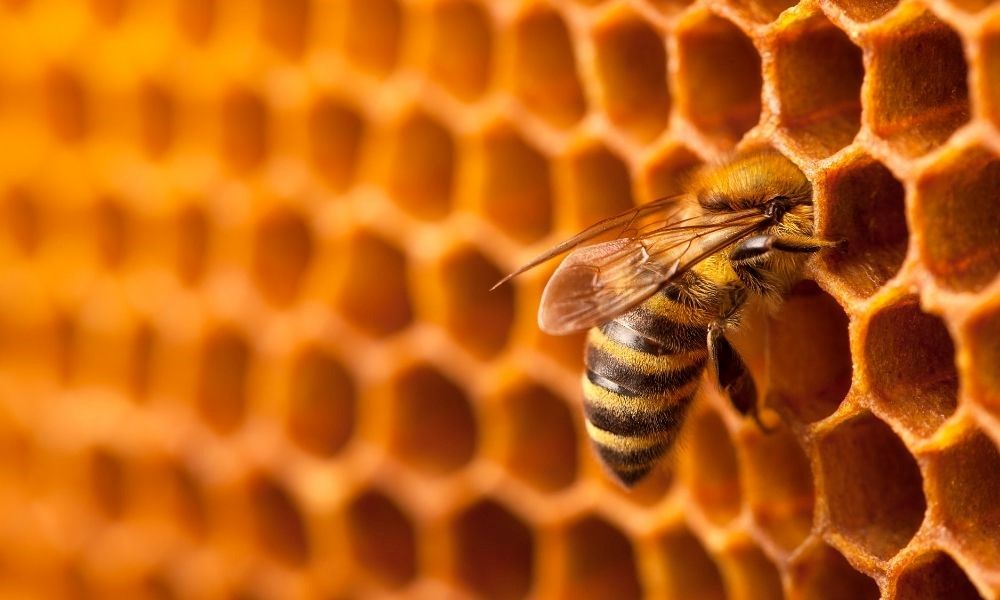Bees and wasps devised the same clever math trick to build nests
Honeybees and yellow jackets don’t look like mathematicians. But working as a colony, these insects can solve a common building problem using a geometric solution.
Some types of bees and wasps live in colonies. These social insects build nests from six-sided — or hexagonal — cells. As their colonies grow, these insects sometimes need to increase the size of the cells. But it’s hard to fit hexagons of different sizes together without wasting materials. And their nest-making material is hard to make. Both the honeybees and wasps have solved this problem: They mixed in some pairs of five-sided and seven-sided cells.
Those alternate cells bridge the gap between different sizes of six-sided hexagons. This fix is close to the best possible solution to this problem, conclude researchers behind the new finding. They reported their results July 27 in PLOS Biology.

Figure 1. Bees and wasps devised the same clever math trick to build nests
Bees and wasps devised the same clever math trick to build nests is shown in Figure 1. “We’ve known for a long time that the hexagonal comb [that] bees and wasps use is the most efficient, stable shape,” says Lewis Bartlett. “But mixing different-sized hexagons is tricky.” Bartlett studies honeybees at the University of Georgia in Athens. He did not take part in the research.[1]
Studying bees and wasps
Certain honey bee and wasp species construct two distinct hexagon sizes: smaller cells house workers, while the larger ones accommodate drones and queens. This discrepancy in cell sizes brings forth a significant architectural issue. How can these two different sized hexagons fit seamlessly within a single comb sheet?
To investigate, researchers gathered nest images from around the world that portrayed both worker and reproductive cells within the same comb. The team was led by Dr. Michael L. Smith, assistant professor in the Department of Biological Sciences at Auburn University and affiliate member of the Max Planck Institute for Animal Behavior.[2]
Bees and wasps came to the same conclusion
The team developed a mathematical model that predicts the number of non-hexagonal cells to incorporate, building upon their findings on the cell-size difference.
The researchers found that some species consistently outperformed the model’s expectations by incorporating intermediate-sized cells into the transition region, reducing the need for non-hexagonal cells.
Despite an evolutionary separation of over 179 million years, bees and wasps appear to have independently arrived at the same architectural solution to handle this scalable issue. Even with distinct building materials and the independent origins of hexagonal cells, they all adopt the same constructional approach.
Striking results
“Once we were able to plot out all the data, the results were striking – you could see how the bees and wasps used intermediate-sized cells to make a gradual change, but also how consistently the non-hexagonal cells were arranged in the comb,” said Dr. Smith.
This study contributes to our understanding of how collective systems can build adaptive and resilient structures without centralized control. The construction of these combs doesn’t rely on a single “architect.” Instead, hundreds, or even thousands, of individual bees and wasps contribute to the final product.
The study, published in the journal PLOS Biology, was supported by the National Science Foundation, the German Research Foundation, a Packard Fellowship for Science and Engineering, and GETTYLABS.
More about bee nests
Bee nests are fascinating structures that bees build to house their colonies. They are intricate and efficient systems built for both the protection and nurturing of the hive’s members. Here’s a closer look at some of the features of bee nests
Material
Bees use wax, which they produce from glands in their abdomen, to build their nests. The most well-known structure inside a bee nest is the honeycomb, composed of hexagonal cells made of beeswax.
Honeycombs
Honeycombs are a marvel of natural engineering. Each cell in a honeycomb is a perfect hexagon, a shape that allows for the most efficient use of space with the least amount of building material. Bees use the cells for a variety of purposes, such as storing honey and pollen, and raising their young.
References:
- https://www.snexplores.org/article/bee-wasp-build-nests-math-geometry
- https://www.mypmp.net/2023/08/03/study-bees-wasps-use-same-tricks-to-build-nests/
- https://www.earth.com/news/bees-and-wasps-use-the-same-nest-building-tricks-despite-independent-evolution
Cite this article:
Gokula Nandhini K (2023), Bees and wasps devised the same clever math trick to build nests, AnaTechmaz, pp.558

